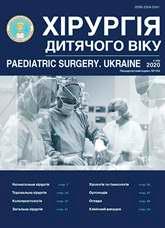Review of the theories of gastroschisis pathogenesis
DOI:
https://doi.org/10.15574/PS.2020.69.86Keywords:
gastroschisis, pathogenesis, vascular disorders, embryonic disordersAbstract
Gastroschisis and omphalocele are the most common congenital malformations of the abdominal wall that required surgical correction. Despite of the long history of the gastroschisis’ study, there is no generally accepted theory of the pathogenesis of this malformation. There are numerous theories of the pathogenesis of gastroschisis discussed in the modern literature: disorders of differentiation of embrionic mesenchyme as the result of teratogenic influence on the early stages of the embryonic development; rupture of amniotic membrane at the base of the umbilical cord; vascular disorders during of the embryonic development; disorders of the yolk-sac escape. Each of existing theories has its supporters and opponents. It is no generally accepted theory of the pathogenesis of gastroschisis. Most likely is the rupture of physiological hernia along the umbilical cord in its pars flaccid, with the subsequent elongation of the midgut out of the abdominal cavity with the vascular compression, especially of venous and lymphatic vessels. Narrow mesenteric root and narrow-sized defect may contribute to various complications that jeopardize the ultimate prognosis. Further studies are needed to finalize the pathogenesis of gastroschisis.
References
Bargy F, Beaudoin S. (2014). Comprehensive developmental mechanisms in gastroschisis. Fetal Diagn Ther. 36(3): 223-230. https://doi.org/10.1159/000360080; PMid:25171094
Beaudoin S. (2018). Insights into the etiology and embryology of gastroschisis. Semin Pediatr Surg. 27(5): 283-288. https://doi.org/10.1053/j.sempedsurg.2018.08.005; PMid:30413258
Byrne JL, Feldkamp ML. (2008). Seven-week embryo with gastroschisis, multiple anomalies, and physiologic hernia suggests early onset of gastroschisis. Birth Defects Res A Clin Mol Teratol. 82(4): 236-238. https://doi.org/10.1002/bdra.20446; PMid:18338390
Christison-Lagay ER, Kelleher CM, Langer JC. (2011). Neonatal abdominal wall defects. Semin Fetal Neonatal Med. 16(3): 164-172. https://doi.org/10.1016/j.siny.2011.02.003; PMid:21474399
Duhamel B. (1963). Embryology of exomphalos and allied malformations. Arch Dis Child. 38(198): 142-147. https://doi.org/10.1136/adc.38.198.142; PMid:21032411 PMCid:PMC2019006
Feldkamp ML, Carey JC, Sadler TW. (2007). Development of gastroschisis: review of hypotheses, a novel hypothesis, and implications for research. Am J Med Genet Part A. 143A(7): 639-652. https://doi.org/10.1002/ajmg.a.31578; PMid:17230493
Frolov P, Alali J, Klein MD. (2010). Clinical risk factors for gastroschisis and omphalocele in humans: a review of the literature. Pediatr Surg Int. 26(12): 1135-1148. https://doi.org/10.1007/s00383-010-2701-7; PMid:20809116
Glick PL, Harrison MR, Adzick NS et al. (1985). The missing link in the pathogenesis of gastroschisis. J Pediatr Surg. 20(4): 406-409. https://doi.org/10.1016/S0022-3468(85)80229-3
Hoyme HE, Higginbottom MC, Jones KL. (1981). The vascular pathogenesis of gastroschisis: intra uterine interruption of the omphalomesenteric artery. J Pediatr. 98(2): 228-231. https://doi.org/10.1016/S0022-3476(81)80640-3
Johns FS. (1946). Congenital defect of the abdominal wall in the new born (gastroschisis). Ann Surg. 123(5): 886-899. https://doi.org/10.1097/00000658-194605000-00014; PMCid:PMC1803672
Kluth D, Lambrecht W. (1996). The pathogenesis of omphalocele and gastroschisis: an unsolved problem. Pediatr Surg Int. 11(2-3): 62-66. https://doi.org/10.1007/BF00183727; PMid:24057518
Komuro H, Hoshino N, Urita Y et al. (2010). Pathogenic implications of remnant vitelline structures in gastroschisis. J Pediatr Surg. 45(10): 2025-2029. https://doi.org/10.1016/j.jpedsurg.2010.04.017; PMid:20920723
Louw JH, Barnard CN. (1955). Congenital intestinal atresia; observations on its origin. Lancet. 269(6899): 1065-1067. https://doi.org/10.1016/S0140-6736(55)92852-X
Moore TC. (1977). Gastroschisis and omphalocele: clinical differences. Surgery. 82(5): 561-568.
Moore TC. (1963). Gastroschisis with antenatal evisceration of intestines and urinary bladder. Ann Surg. 158(2): 263-269. https://doi.org/10.1097/00000658-196308000-00017; PMid:14047550 PMCid:PMC1408534
Moore TC, Stokes GE. (1953). Gastroschisis: report of two cases treated by a modification of the gross operation for omphalocele. Surgery. 33(1): 112-120.
Rittler M, Vauthay L, Mazzitelli N. (2013). Gastroschisis is a defect of the umbilical ring: evidence from morphological evaluation of stillborn fetuses. Birth Defects Res A Clin Mol Teratol. 97(4): 198-209. https://doi.org/10.1002/bdra.23130; PMid:23554304
Sadler TW. (2010). The embryologic origin of ventral body wall defects. Semin Pediatr Surg. 19 (3): 209-214. https://doi.org/10.1053/j.sempedsurg.2010.03.006; PMid:20610194
Sadler TW, Feldkamp ML. (2008). The embryology of body wall closure: relevance to gastroschisis and other ventral body wall defects. Am J Med Genet C Semin Med Genet. 148C(3): 180-185. https://doi.org/10.1002/ajmg.c.30176; PMid:18655098
Sadler TW, Rasmussen SA. (2010). Examining the evidence for vascular pathogenesis of selected birth defects. Am J Med Genet A. 152A(10): 2426-2436. https://doi.org/10.1002/ajmg.a.33636; PMid:20815034
Shaw A. (1975). The myth of gastroschisis. J Pediatr Surg. 10(2): 235-244. https://doi.org/10.1016/0022-3468(75)90285-7
Stevenson RE, Rogers RC, Chandler JC et al. (2009). Escape of the yolk sac: a hypothesis to explain the embryogenesis of gastroschisis. Clin Genet. 75(4): 326-333. https://doi.org/10.1111/j.1399-0004.2008.01142.x; PMid:19419415
Tibboel D, Raine P, McNee M et al. (1986). Developmental aspects of gastroschisis. J Pediatr Surg. 21(10): 865-869. https://doi.org/10.1016/S0022-3468(86)80009-4
Toth PP, Kimura K. (1993). Left-sided gastroschisis. J Pediatr Surg. 28(12): 1543-1544. https://doi.org/10.1016/0022-3468(93)90091-X
deVries PA. (1980). The pathogenesis of gastroschisis and omphalocele. J Pediatr Surg. 15(3): 245-251. https://doi.org/10.1016/S0022-3468(80)80130-8
Yang P, Beaty TH, Khoury MJ et al. (1992). Genetic-epidemiologic study of omphalocele and gastroschisis: evidence for heterogeneity. Am J Med Genet. 44(5): 668-675. https://doi.org/10.1002/ajmg.1320440528; PMid:1481831
Downloads
Published
Issue
Section
License
The policy of the Journal “PAEDIATRIC SURGERY. UKRAINE” is compatible with the vast majority of funders' of open access and self-archiving policies. The journal provides immediate open access route being convinced that everyone – not only scientists - can benefit from research results, and publishes articles exclusively under open access distribution, with a Creative Commons Attribution-Noncommercial 4.0 international license(СС BY-NC).
Authors transfer the copyright to the Journal “PAEDIATRIC SURGERY.UKRAINE” when the manuscript is accepted for publication. Authors declare that this manuscript has not been published nor is under simultaneous consideration for publication elsewhere. After publication, the articles become freely available on-line to the public.
Readers have the right to use, distribute, and reproduce articles in any medium, provided the articles and the journal are properly cited.
The use of published materials for commercial purposes is strongly prohibited.

